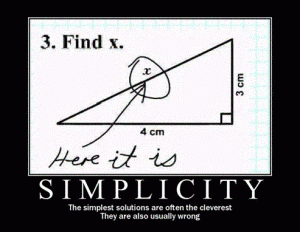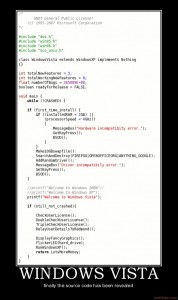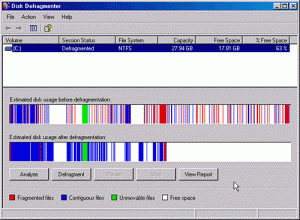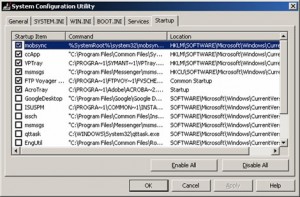How-to Tuesday: Speed Up a Windows PC
Today’s post has nothing to do with models, and everything to do with the machine you’re (likely) viewing this blog on. If you’re a Mac owner, congratulations on choosing a platform that gives free upgrades to the Operating System (OS). That’s pretty dang handy. If you’re a Linux User, your OS is not the limiting factor in your computer speed, so go play with your root – this article isn’t for you.
Why should the rest of you listen to me? I have a Computer Engineering degree from Purdue University, and all my family members make me program their DVRs. So there.
 A Foundation
A Foundation
A computer is like a kid doing math homework. The book containing the problems and instructions is the Hard Drive: permanent storage. The pencil and paper are the computer’s RAM: it’s the (temporary storage) space used to execute the instructions. The kid’s brain is the processor: interpreting the instructions and generating output, step-by-step.
Those are the three primary components of a computer: Hard Drive (permanent storage), RAM (temporary storage) and processor (executes instructions). If any of those components gets bogged down, or becomes insufficient compared to the other two, the computer slows down.
 Operating System
Operating System
Firstly, if you’re reading this far, I’m assuming you have a Windows Operating System (OS). If it’s XP or Windows 7, skip ahead. If you have Vista, get a box of Kleenex.
Vista was a great idea, executed horribly; primarily due to it’s RAM management. Whenever a program gets started up, it requests some room in the computer’s RAM. This takes a small, but not insignificant amount of time. The PC has to check how much RAM is available, what sections are free, and if there’s not enough room, it has to juggle multiple programs.
Vista took the following approach to RAM: If Vista requests about half the RAM, it won’t have to rely on the hardware (the physical chips on the circuit boards) to manage RAM – Vista can manage the RAM space in software. IE, Microsoft took control away from the circuit builders, and tried to do everything on it’s own.
While that’s a great idea, the problem becomes apparent when you realize that a processor can only execute one instruction at a time. This means that Vista has several thousands of extra instructions it has to get through every time a program starts or is running. That wouldn’t be a problem if the processor was faster and could handle the necessary volume, but of course, that’s not the case.
What ends up happening is that the computer is perpetually stuck in rush hour traffic on the highway. The processor speed (road size in the rush hour analogy) hasn’t changed, but all of a sudden, there’s 10 times the traffic, and stuff just gets backed up.
How do you fix this? You don’t. Neither did Microsoft. They just said “oops” and released Windows 7, which is essentially Vista, but without the custom RAM management. They went back to letting the chips handle the musical chairs. So, if you have Vista – upgrade to Windows 7 (or downgrade back to XP if you can find a copy).
Sorry.
Task Bar Party
Look down at the task bar, in the bottom right of the Windows screen. There’s a small section that has icons in it, usually one per program running. Often, there’s a button on the left side of the section, expanding it. If there’s more than about 4-5 icons in there when your computer is sitting doing nothing, you are probably suffering from a RAM bottleneck.
Computer programs are selfish and conceited. When most programs are installed, they add themselves to a list of programs that are executed whenever a computer starts up (cleverly enough, this is called the startup list). They do this so that their major functions are pre-loaded into the Operating System. That way, when you choose to start the program, it loads faster, thus looking like a nice, quick, easy-to-use program.
Great idea, right? Sure, if it’s only 1-2 programs. Unfortunately, every program does this, and over the course of a few months or years, your computer is struggling to maintain 20-30 pre-loaded programs and their functions, as well as whatever actual tasks you’re doing while on the computer.
Going back to the kid doing math analogy, it’s like asking the kid to do his homework while someone paints on his worksheet with a paintbrush, and another person is setting it on fire, and a third is trying to eat it. There’s no way he’s going to get anything done – he’ll have to keep re-starting the math problem over and over and over again.
How do you fix this? Try this.
- Click Start (then click RUN in XP)
- Type “msconfig” (without quotes), hit enter
- Select the “Startup” tab
- Click “Deselect All”
- Click Exit (Restart when prompted)
Ta Da!
Hard Drive Bottleneck
This is the last of my solutions, and one that is sometimes hard to diagnose. While your Hard Drive may have plenty of space, if it has to work too hard to retrieve the data you want, then this can result in a slow PC.
Imagine you are tasked with maintaining a record, and all you have is a pen and paper. As the record is told to you, you write it down. However, the person who is telling you this record keeps amending what they mention earlier. Now imagine that you cannot go back and correct your previous entry. Instead, to keep track of changes and updates, you must add an addendum each time a change or update occurs. Over time, you have a mangled, tangled mess of original data, changes and updates to that data, and some how you have to remember how it all relates to each other. It would be a nightmare.
That is a Hard Drive’s world. It cannot insert data into the middle of a record, instead, it can only attach it to the next available chunk of free space, and then map that small update to where it should be long in the original group of data. So, if you have a folder of mp3s that you’ve been collecting for years, those mp3s are not all lumped nicely on the Hard Drive like they are on your desktop. Instead, they are scattered all over the Hard Drive, because they were put where ever there was enough room.
 To fix this problem, one must de-fragment the Hard Drive. This is a long, grueling process, and is best done overnight. When a Hard Drive is defragmented, it looks at all the data on the disk, and figures out what chunks belong together. Then, it uses the computer’s RAM as temporary storage, and starts shuffling chunks of data until they bits and pieces are grouped better. This means the Hard Drive is no longer having to jump all over it’s records to play a single song or display a document.
To fix this problem, one must de-fragment the Hard Drive. This is a long, grueling process, and is best done overnight. When a Hard Drive is defragmented, it looks at all the data on the disk, and figures out what chunks belong together. Then, it uses the computer’s RAM as temporary storage, and starts shuffling chunks of data until they bits and pieces are grouped better. This means the Hard Drive is no longer having to jump all over it’s records to play a single song or display a document.
Disk defragmentation is easily started by doing the following:
- Right-click on your Hard Drive, and select Properties.
- Find a “Hardware” or “Tools” tab.
- Click on the “Defragment” button.
- Click the “Defragment Now” button.
- Go to Bed.
I highly suggest defragmenting 3-4 times a year. If you download lots of stuff, or if you’re a writer or video gamer, defragment more often.
Conclusion
The two most common causes of slow PCs are too many programs running during startup, or a messy Hard Drive. So long as you keep those two issues under check, your PC should run as fast as it did when it came off the assembly line.
If you have any questions regarding Computers, feel free to ask in the comments below!


Happy Holidays!